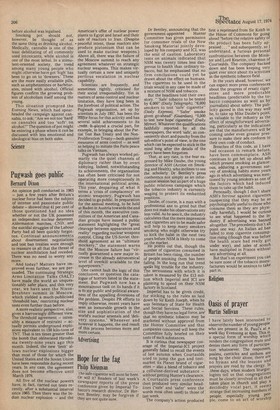Advertising
Hope for the fag
Philip Kleinman
the safe cigarette will soon be here. Or will it? Readers of last week's newspaper reports of the press conference given by Imperial Tobacco's research director, Dr Herbert Bentley, may be forgiven if they are not quite sure. Dr Bentley, announcing that the government-appointed Hunter Committee has given permission for consumer trials of the New Smoking Material jointly deve loped by his company and ICI, was the soul of caution. Laboratory tests on animals indicated that NSM was twenty times less dan gerous to health than ordinary tobacco, but he emphasised that no firm conclusions could yet be drawn about the effect on humans. The cigarettes to be used in the trials would in any case be made of a mixture of NSM and tobacco.
But the headlines told their own story. "'Safe' tobacco to be tested
by 6,000" (Daily Telegraph), "6,000 smokers to test 'safe' cigarette" (Daily Express), "'Safer' smoke
given go-ahead" (Guardian), "5,000 to test new hope' cigarettes" (Daily Mirror). Whatever the qualifications faithfully reported by all the newspapers, the word 'safe', so conveniently short and punchy from the sub-editor's point of view, is the one which can be expected to stick in the mind long after the details of the story have been forgotten.
That, at any rate, is the fear expressed by Mike Daube, the young director of ASH (Action on Smok ing and Health), who inclines to see the scholarly Dr Bentley's press conference not simply as an infor mation session but as part of a huge public relations campaign which the tobacco industry is currently waging to protect its embattled positions. Daube, of course, is a man with a professional axe to grind but that' does not make his observations any less valid. As he sees it, the industry calculates that the mere impression that cigarettes are to be made safer will help to keep many smokers smoking who might otherwise try to kick the habit in the next two years before NSM is likely to come on the market. He points out that, though the number of cigarettes consumed in Britain has been rising, the number of people smoking them has been falling. In the long run that trend spells big trouble for the industry. The seriousness with which it is taken is measured by the £13 mil lion which Imperial and ICI are planning to spend on their NSM factory in Scotland.
Imperial. has to be given credit, for sticking to the rules as laid
down by Sir Keith Joseph, when he was Secretary of State for Health and Social Services. These rules, though they have no legal force, are' that no synthetic tobacco may be marketed without approval from the Hunter Committee and that companies concerned will keep the Committee fully briefed on their tests of such substances.
It is curious that newspaper coverage of the Imperial-ICI project generally failed to recall the events of last autumn when Courtaulds tried to jump the gun and testmarket its Planet brand of cigarettes — also a blend of tobacco and a cellulose-derived substance — without getting Hunter's clearance. A Courtaulds press conference then produced very similar headlines ('safe' and 'safer' were the ' words most often used) to those of last week.
The company's action produced first a reprimand from Sir Keith in the House of Commons for going ahead "before the relative safety of the product has been fully ap
praised " and subsequently, so I understand, a furious personal confrontation between the Minister and Lord Kearton, chairman of Courtaulds. The company backeddown and has been keeping very quiet ever since about its activities in the synthetic tobacco field.
In the years ahead, however, we can expect more press conferences about the progress of ersatz cigarettes and more predictable headlines (predictable by the tobacco companies as well as by journalists) about safety. The publicity gained in this way may well be, to take up Mike Daube's point, as valuable to the industry as the effect of straightforward advertising, particularly as the indications are that the manufacturers will be coming under even greater pressure to make their ads conform to their own code of conduct.
Breaches of this code, as I have had occasion to remark before, have been commonplace. ASH continues to get het up about ads which present smoking as glamorous, adducing a government survey of smoking habits some years ago in which advertising was mentioned by young smokers as one of the factors which had induced them to take up the habit.
Personally, though I don't share ASH's fervour against cigarettes (suspecting that they may be as psychologically useful to those who consume them as they are physically harmful), I would be curious to see what happened to the industry if advertising was banned altogether. The precedents don't all point one way. An Italian ad ban failed to stop cigarette consumption rising (though that was before the health scare had really got under way), and sales of scotch have multiplied in France without any advertising at all. But that's an experiment you can be sure none of the tobacco manufacturers would be anxious to take part in.


































 Previous page
Previous page